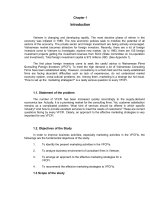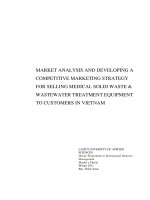A MARKETING STRATEGY FOR SUSTAINABLE GROWTH CASE STUDY: SKY-MEDIA COMPANY LIMITED
Bạn đang xem bản rút gọn của tài liệu. Xem và tải ngay bản đầy đủ của tài liệu tại đây (924.92 KB, 47 trang )
<span class="text_page_counter">Trang 1</span><div class="page_container" data-page="1">
<b>A marketing strategy for sustainable growth</b>
Case study: Sky-media company limited
Thi Minh Trang Dinh
BACHELOR’S THESISMay 2019
Degree Programme in International Business
</div><span class="text_page_counter">Trang 2</span><div class="page_container" data-page="2">Key words: sustainable growth, marketing
<b>ABSTRACT </b>
Tampereen ammattikorkeakoulu
Tampere University of Applied Sciences Degree Programme in International Business THI MINH TRANG DINH:
A Marketing Strategy for Sustainable Growth Case Study: Sky-media Company Limited
Bachelor's thesis 47 pages, appendices 2 pages May 2019
Sustainability is becoming a vital concept for businesses nowadays. Therefore, the purpose of this dissertation was to analyse Sky-media's business situation using existing theories and media industry information.
In the theoretical part, the idea of sustainability and sustainability marketing strategy were addressed. The data were gathered from public references such as books, articles and websites. The empirical part included the company basic information and company's analysis. Quantitative and qualitative method using semi-structured interview ( face-to-face and email interview) were used in this study.
In the discussion section, the collected information was used to answer the research questions, and the author gave some recommendations.
It was found that Sky-media's marketing strategy has already included the idea of sustainable marketing. However, one of the suggestions for the company's growth is to create new potential products by cooperating with competitors in-stead of competing. It would be interesting to consider sustainability marketing from the government's perspective since it could help the start-ups to utilise the current policies.
</div><span class="text_page_counter">Trang 3</span><div class="page_container" data-page="3">3 THE SUSTAINABILITY MARKETING STRATEGY ... 11
3.1 Sustainability marketing mix ... 12
3.2 Strategic marketing ... 14
4 SKY-MEDIA ANALYSIS ... 17
4.1 Overall information ... 17
4.1.1 Business process management ... 19
4.1.2 General business status ... 22
5.2 Reliability and validity of the research work ... 40
5.3 Suggestion for future research ... 41
REFERENCES ... 42
APPENDICES ... 46
Appendix 1. Initial interview questions ... 46
</div><span class="text_page_counter">Trang 4</span><div class="page_container" data-page="4"><b>1 RESEARCH BACKGROUND </b>
In the last ten years, the trend of start-up companies has boomed worldwide. Entrepreneurs play an important role in the economy as a whole. The economy is developed and expanded by start-up companies which opens up career op-portunities for people. Furthermore, start-ups are perfect incubators of innova-tion which is crucial for a capitalist system. However, according to recent start-up statistics, more than fifty per cent of small businesses could not last until in the fifth year. Thus, understanding small-business growth strategies with sus-tainability in mind is crucial than ever before. The mainstream resources focus on development strategies for large co-operations which is not always suitable for small companies, especially start-ups.
The motive for writing this report started from a personal interest in ity. After working for a Japanese start-up in Vietnam and meeting other entre-preneurs, the author of this dissertation found finding relevant information about developing sustainability strategies for small enterprises difficult sometimes. Therefore, the author concluded that there is still room for improvement con-cerning marketing strategies for sustainable growth.
sustainabil-Vietnam has about ninety-five million residents, and there are sixty-seven vision stations with nearly one hundred television channels broadcasting through different technologies. The demand for movies and television programs is increasing since the living standards have been improved greatly over the past decades. Media firms have the potential to bloom in the Vietnamese mar-ket. However, the sustainable growth is an issue for a start-up due to tight com-petition and product diversity in the media industry. One of the participants in this competitive race is Sky-media. It is a start-up media company located in Hanoi -Vietnam capital. It was founded in 2016 by Ms Mai Phuong Nguyen who has more than ten years of experience in the very industry. The company cur-rent main focus is to purchase copyright films, TV programs from Vietnam, Tai-wan, Korea, Japan, and sell them to domestic channels and other local media companies. The research is essential because Sky-media’s goal is to grow its business in a profitable way with sustainability in mind. As the thesis will discuss sustainable marketing strategies and strategic analysis both externally and in-
</div><span class="text_page_counter">Trang 5</span><div class="page_container" data-page="5">tele-ternally, the other start-up companies in media industry facing the same lem regardless of their business model can use it as a reference source.
<b>prob-1.1 Objectives and research questions </b>
Profitable development is always one of a company's top goals regardless of business form and its size. The main objective of this thesis process is to pre-sent and analyse the current situation of Sky-media company, link to and com-pare with existing theoretical and industry-specific information, and provide some practical recommendations to Sky-media for their performance improve-ment. In order to collect research data effectively, the concept of sustainable marketing will be reviewed, and the theory of sustainable marketing strategies will be presented. From this follows the main research questions and sub-questions.
<b>1.2 Theoretical framework </b>
The theoretical part is divided into sustainability marketing and the sustainability marketing strategy part. Besides, PESTLE and SWOT theory will be applied in the case of Sky-media company. While the PESTLE analysis will analyse mac-ro-environment which will present opportunities and challenges, the SWOT analysis will analyse the internal factor of the company.
<b>1.3 Research methods </b>
</div><span class="text_page_counter">Trang 6</span><div class="page_container" data-page="6">
<i><small>FIGURE 1. Thesis structure </small></i>
Generally, the purpose of the research is to explore, describe, and explain a phenomenon that occurs in life. To support the study, researchers often ap-proach the problem with two basic methods: qualitative and quantitative re-search.
Quantitative research is a study that explains phenomena by analysing cal data which is collected by mathematical methods. This type of study often emphasises the causal relationship between isolated variables within a frame-work which is reductionistic and logical, based on a priori theories. Qualitative research is primarily focused on exploratory research. This research method helps to understand the causes, perspectives and motives behind a phenome-non. It usually provides a much more insightful view than quantitative research. The objective of this research study is about the analysis of the current busi-ness situation and create a strong growth strategy based on practical theories which the author has learned at Tampere University of Applied Sciences. The research approach will be deductive. Both quantitative and qualitative research methods will be applied to the research project (Yilmaz 2013, 311).
numeri-Data is collected from both primary and secondary sources. For the theoretical part, books, articles and websites are used as reference resources. The empiri-cal part includes data from interviews conducted by the author with Sky-media representative and from surveys related to the media industry in Vietnam.
<b>1.4 Thesis structure </b>
The dissertation consists of five chapters. Thesis’s structure is shown in figure 1.
</div><span class="text_page_counter">Trang 7</span><div class="page_container" data-page="7">Chapter one will present the research background. Chapter two will introduce the idea of sustainability marketing and why it is crucial nowadays. The third chapter will present the elements of sustainability marketing strategy in theory. In chapter four, all the mentioned theories will be applied to analyse the Sky-media case. The final chapter will focus on recommendations based on the the-ories and data analysis so that Sky-media could grow profitably in a sustainable way.
<b> 2 SUSTAINABILITY MARKETING </b>
While the first part of this chapter will introduce the definition of sustainability in business according to the available secondary data, the second part will give an overview of sustainability marketing in theory.
<b> 2.1 Sustainability </b>
About 50 years ago, the goal of business development mainly was to increase profits as much as possible regardless of the impact on the environment, which has led to serious consequences for future generations. Thus, the topic of " sus-tainability" is more concerned than ever. Nowadays 62% of business executives consider that a sustainability strategy is necessary to become competitive, and another 22% think it will be in the future.
In 1987, Our common future report, also known as the Brundtland Report was published and laid a foundation for the idea of " sustainable development". Ac-cording to the Brundtland Commission, sustainable development is the devel-opment that meets the needs of the present without compromising the ability of future generations to meet their own needs (WCED, 24). Sustainability is about finding the dynamic balance of three core pillars of any business - environment, society and economy (Our Common Future 1987). Often, sustainability is pre-sented as the visual model below.
</div><span class="text_page_counter">Trang 8</span><div class="page_container" data-page="8">The diagram shows the integrated nature of the concept of Sustainability. The circles represent the environment, the society and the economy. Economic sus-tainability can be achieved by ensuring profitable growth and covering the aver-age sustainable production costs. Social sustainability is closely connected to employees' basic human rights. The actions taken by employers to protect the environment in which they work and live will eventually lead to environmental sustainability. The ability to apply effective integration of the sustainability con-cept in the management of an organisation is very powerful and plays a key role in the decision- making process.
<b> 2.2 Sustainability marketing definition 2.2.1 Definition </b>
There is a variety of definitions. Several interpretations will be examined to tablish this thesis theoretical foundation.
es-In 1995, Sheth and Parvatiyar published an article entitled Ecological tives and Role of Marketing, which covers the idea of sustainable marketing. According to Sheth and Parvatiyar (1995, 3–7), sustainable marketing can only be achieved when there is close cooperation between the companies and the
<i><small>Impera-FIGURE 2. Sustainability (Sustainability – What can ...n.d.) </small></i>
</div><span class="text_page_counter">Trang 9</span><div class="page_container" data-page="9">activities of the government. To promote a sustainable economy, the objective of sustainable marketing is to shape customers' needs and deliver suitable products without neglecting the future needs. However, this concept omits the role of social factors. Adam and Apeldoorn (1996, 45–46) also believed that the optimal regulative framework to manage the marketing role in a restricted eco-logical space is essential for sustainable marketing.
“Sustainability marketing may be defined as building and maintaining ble relationships with customers, the social environment and the natural envi-ronment”. (Belz & Peattie 2012, 29).
Belz and Peattie (2009, 30–31) tried to clarify the difference between ble marketing and sustainability marketing. Sustainable marketing implies a long-lasting relationship with customers while sustainability marketing involves all important issues such as ecological, economic and social.
sustaina-Since the idea of sustainability marketing covers all sustainable development principles, in the context of this research, the term sustainability marketing will be used.
<b>2.2.2 Key elements </b>
Frank-Martin Belz and Ken Peattie (2012, 28) describe that sustainability keting is formed of six key elements from the managerial perspective as listed below:
mar- Socio-ecological issues Consumer behaviour
Sustainability marketing values and objectives Sustainability marketing strategies
Sustainability marketing mix
Sustainability marketing transformation.
</div><span class="text_page_counter">Trang 10</span><div class="page_container" data-page="10">The difference between conventional marketing and sustainable marketing is that businesses set specific marketing values and objectives, which are achieved through interaction with customers (Belz & Peattie 2012, 124 -129). Sustainability marketing values: Every business must determine its core value expressed through vision, mission and philosophies to create brand ethos. In turn, the brand ethos will provide guiding principles in companies operating ac-tivities (Sustainable Marketing… 2017).
Sustainability marketing objectives: The target of sustainable marketing must meet the three main requirements that are short-term and long-term economic objectives, social objectives and environmental objectives. On the contrary, conventional marketing focuses primarily on the economic aspects and evalu-ates the effectiveness of marketing performance by short-term financial devel-opment.
<b>Economic objectives </b>
Increasing the revenues and market share of sustainable products and vices, and developing long-term customer satisfaction are important economic development goals of well-established businesses (Belz & Peattie 2012,129).
<b>ser-Social objectives </b>
Concerning sustainable development, the company's products and services must be safe to use and do not affect consumers' health. Moreover, company owners must take the necessary steps to ensure the well-being of their stake-holders including employees, contractors, suppliers and so on (Belz & Peattie 2012,131).
<b>Ecological objectives </b>
Ecological goals play an essential role in motivating enterprises to minimise vironmental impacts within a product life cycle. According to Life Cycle Assess-ment (LCA), some of the following elements could be used to set ecological ob-
</div><span class="text_page_counter">Trang 11</span><div class="page_container" data-page="11">en-jectives: material use (toxic materials, non-renewable and renewable energies usage), water use, emissions, effluents, waste such as toxic materials, non-recyclable wastes (Belz & Peattie 2012, 130; Ottman 2011, 59).
<b>3 THE SUSTAINABILITY MARKETING STRATEGY </b>
An effective marketing strategy will increase revenues and thus, helps the pany to grow. In general, if a combination of the marketing mix, sustainability principles and strategic marketing will be applied properly to create a sustaina-bility marketing strategy, enterprises are more likely to survive in a competitive market.
com-According to Barry and Stephen in their book - "Sustainable development egies: a resource book", they argue that a long-term learning process is needed in creating the suitable sustainability policy because of various challenges in sustainable development. Due to different circumstances, firms should avoid adopting rigid or blueprint approaches (Dalal-Clayton & Bass 2002, 30 -50). Alt-hough Barry and Stephen discussed the sustainability policy at the national lev-el, this theory could be applied at the individual level. The figure below shows the systematic approach to sustainability strategies.
<i><small>strat-FIGURE 3. A sustainable development approach (Dalay-Clayton & Bass 2002, 32) </small></i>
</div><span class="text_page_counter">Trang 12</span><div class="page_container" data-page="12">The figure shows that strategy development is in a sequence of steps. er, in practice, the approach to sustainability strategies is a continuous cycle which allows adjustments to be made at any time based on the result of the monitoring and evaluation process.
<b> 3.1 Sustainability marketing mix </b>
The application of the marketing mix into business strategy to achieve ing goals has been widely applied for a long time. There are two main marketing mix models: marketing mix 4P and marketing mix 4C. In 1960, McCarthy pro-posed a model of marketing mix 4P consisting of four main elements: product, price, place, promotion. In 1990, Lauterborn introduced the concept of market-ing mix 4C model including four main variables: consumer, cost, communica-tion, and convenience. Marketing mix 4P considers from the seller's perspective while marketing mix 4C considers from the customer's perspective. In the best interest of marketers, it is crucial to take into consideration both the consumer's viewpoint and the organisation's viewpoint. Therefore, this section will explain the 4C model by comparing it with the 4P model.
market-The figure below shows the transition from the traditional 4P model to the tainable mix marketing model 4C.
<i><small>sus-FIGURE 4. 4P's versus 4C’s ( Marketing Mix 4C’s n.d.)</small></i>
</div><span class="text_page_counter">Trang 13</span><div class="page_container" data-page="13"><b>Customer (and Product) </b>
Instead of focusing on products, the 4C model objective is to provide a product which suits customer specific desires. If the company wants to sell the product with high accuracy, a detailed understanding of the customer is needed. There-fore, it is essential for marketers to conduct in-depth research on consumers' needs and wants. However, products are still the core of all marketing efforts. The company's products must be unique and desirable to compete in the mar-ket. This, in turn, requires research on product features to bring the best bene-fits to customers (Anastasia 2015).
The most effective way to balance both models is to learn about new market segments and then focus on product development instead of trying to bring the ready-made product into new markets. The product testing step is necessary for both the customer variable and the product variable. Understanding the product advantages from the standpoint of the client and manufacturer is the key ele-ment.
<b>Cost (and Price) </b>
From the aspect of the manufacturer, the price is the amount of money that a consumer is willing to spend on purchasing a product or service. If a product is undervalued or overvalued than its perceived value, it can not be sold. Thus, purchasing price positioning is important for enterprises.
However, from the customer's viewpoint, the cost covers more aspects than the price. Price is only one of the factors which determines whether the customer will acquire a product or service. There are many cost factors, for instance, the cost of time to purchase products, the cost of conscience when using the prod-ucts and the cost of not buying an alternative.
The clear understanding of the target market including the customer satisfaction cost will help the company to find a solution to increase the price while decreas-ing the cost to satisfy customer's need.
</div><span class="text_page_counter">Trang 14</span><div class="page_container" data-page="14"><b>Communication (and Promotion) </b>
Traditionally, promotion is understood as marketing communication to promote businesses themselves. Promotion strategies, the main purpose is to reach the customer, may include advertising campaigns, offers and public relations. However, according to Lauterborn, communication is a cooperative activity cen-tring on the purchasers rather than the sellers. Communication shifts toward building a personal relationship with consumers based on their needs and wants. This type of modern marketing communication will allow marketers to deepen their understanding of their potential customers and increase the chance of customer loyalty.
<b>Convenience (and Place) </b>
The concept of " place" or "placement" is usually connected to the traditional value chain involved in getting a product into a customer’s hand. Because of rapid technology development, the process of purchasing a product has been simplified. The key factor here is that traders must be aware of the buying hab-its of specific customer groups to make it easy, simple, and fast for them to avail of product(s) or service(s).
<b> 3.2 Strategic marketing </b>
The elements such as the business environment, the interaction between the company and the stakeholders may influence the sustainable development of a company. Hence, marketers can follow five marketing steps proposed by Belz and Peattie to form a good business tactic: (1) screening sustainability actors and issues, (2) segmenting sustainability markets, (3) introducing sustainability innovation, (4) Positioning sustainable products and (5) partnering with sustain-ability stakeholders (Belz & Peattie 2012, 137).
<b>Screening sustainability actors and issues </b>
</div><span class="text_page_counter">Trang 15</span><div class="page_container" data-page="15">Today, social and environmental issues stemming from economic activities come very popular and diverse. It is advisable for marketers to be up-to-date with the problems using tools such as the issue-attention cycle graph. When the problem is on the rise, it will affect consumer behaviour. Examining and captur-ing the trend of proactive factors such as social media, politics and society will help companies to develop marketing approaches that are harmonious with their customers' opinions ( Belz & Peattie 2012, 149 -150).
<b>be-Segmenting sustainability markets </b>
When categorising customers as accurately as possible, merchants can direct their efforts to the right customer group for their sustainability goods. There are four common factors used in segmentation: demographic, behavioural, psycho-graphic, and geographic.
Demographic segmenting: Demographic segmentation is one of the most widely applied methods. Individual variables such as age, gender, income, occupation, belief, and nationality classify buyers demographically (Bhasin 2019).
Behavioural segmenting: Each client is different in behaviour, shopping quency and decision-making pattern. Thus, based on the practice of an individ-ual, products are marketed.
fre-Psychographic segmenting: Although the classification of customers based on psychographic is similar to behaviour segmentation, psychographic marketing strategies often involve lifestyle, interests and opinions.
Geographic segmenting: Each customer group will have different needs pending on where they live. This type of market segment divides potential cus-tomers based on geographical location.
<b>de-Introducing sustainability innovation </b>
</div><span class="text_page_counter">Trang 16</span><div class="page_container" data-page="16">Innovation and time are two indispensable elements in building, developing and maintaining the business success. According to Belz and Peattie, there are four ways firms can innovate their products as shown in the table below.
The first way aligning with the traditional definition of innovation is to create new technology to address the current problems. The second way is to use existing technology to a new market. Another way is to formulate the incorporation of technological and non-technological modifications. The last strategy is exnova-tion which means the companies will discard familiar market areas and improve technology in new fields. In short, sustainable innovation focuses on the devel-opment of technology and services to bring about social and environmental benefits.
The moment to propose novelty to the market is very important. If the latest technology will be introduced in an early stage, companies may have the ad-vantage of having a larger market share and creating entry-barriers for competi-tors. However, if the customer’s willingness to buy new products is less than the customer’s interest, entering the market with advanced technology can put the business at a disadvantage place (Belz & Peattie 2012, 156).
<b>Positioning sustainable products </b>
Green products, environmentally friendly and good ethics often offer a ble position for sustainable products. Hence, the way marketers delivering their image status to consumers may affect their goods position on the market.
<i><small>favoura-FIGURE 5. Sustainability innovation (Belz & Peattie 2012, 156) </small></i>
</div><span class="text_page_counter">Trang 17</span><div class="page_container" data-page="17">Belz and Peattie recommend four approaches that marketers can adopt for their sustainable products to reach competitive position depending on the market and product type (Belz & Peattie 2012, 160):
Direct attention to socio-ecological value rather than performance and price
Equal focus on performance, price and socio-ecological benefit Promoting socio-ecological value as a part of the product essence No advertisement for socio and environmental advantages of products.
<b>Partnering with sustainability stakeholders </b>
When considering sustainable development related to the environment or ogy, this is a responsibility of the whole society, not only the businessmen. If social elements such as corporations, employees, customers, suppliers, gov-ernment, trading partners have good coordination, the aim of sustainable growth could be easier to achieve. For example, advertisers can attract the par-ticipation of customers, employees or other stakeholders in a campaign to raise environmental awareness. This type of movement is beneficial for the communi-ty as well as the business since it advertises the brand name (Belz & Peattie 2012, 165).
<b>ecol-4 SKY-MEDIA ANALYSIS </b>
Chapter 4 will provide more detailed information on many aspects of Sky-media company. Furthermore, the SWOT and PESTEL models combined with sus-tainability marketing principles will be applied to analyse the company situation in terms of micro and macro.
<b> 4.1 Overall information </b>
Ms Mai Phuong Nguyen has worked as a manager in a large media corporation for decades. Thus, she is very experienced in this business field. Because Ms Phuong would like to do business using her ideas, she determined to establish her own company. In 2016, Sky-media was founded. Sky-media represents the
</div><span class="text_page_counter">Trang 18</span><div class="page_container" data-page="18">founder's desire to succeed in the domestic market and in time, the international market.
When newly established, besides the economic objective, the company's social objective is to provide job opportunities and a transparent work environment for Vietnamese. The foremost vision of Sky-media is to become a large media company operating in many areas of communication such as advertisement, exclusive television programs production and copyright of foreign shows.
The total number of employees is 15 persons, including ten official workers and five interns. As Sky-media is a small company, its structure is simple as shown in the figure below.
The founder owns the business and has the right to decide all the development strategies of the company.
The CEO is the representative of the founder, administers the business operation and reports back to the founder. The CEO is responsible for signing contracts, managing personnel and announcing the founder's requirements and assigning tasks to each department.
<i><small>FIGURE 6. Company structure </small></i>
</div><span class="text_page_counter">Trang 19</span><div class="page_container" data-page="19">The marketing department is in charge of finding, maintaining and developing customer relationship which involves doing research on the demand trend and managing advertising campaigns.
The purchasing department is responsible for purchasing the products and selling them to customers. Furthermore, the Purchasing team has to work closely with the outsourced delivery team to ensure product arrival time.
The accounting department is account for controlling financial and accounting resources. Besides, the accounting team needs to make financial business report monthly, quarterly, yearly as well as handling taxable under the provisions of the state.
The legal department ensures the company's operations are within the namese legal framework. It is in charge of updating laws to prepare suitable contracts for the purchasing department. Besides, the legal department is also responsible for copyright disputes.
<b>Viet-4.1.1 Business process management </b>
The business process is the continuous steps taking place to achieve a company's specific goal. Sky-media's business process can be divided into two simple stages: the buying of products and trading products.
<b>Purchasing process </b>
The Sky-media process of purchasing is explained in figure 7.
</div><span class="text_page_counter">Trang 20</span><div class="page_container" data-page="20">In the film obtaining process, market research and business forecast are tremely necessary. Based on the annual analysis reports of media and press organisations and the actual operation of national television channels, Sky-media analyses market demand. During market research, the marketing de-partment will contact partners and ask for the detailed quotation of copyrighted programs. Thanks to the collected data, the marketing and accounting depart-ment will estimate the product's effectiveness by the potential number of inter-ested buyers and payback period and interest. The most feasible plans will be submitted to the director for approval. Then employees will contact potential providers who are usually film production companies and TV stations. Some-times the company also acquires copyrights from foreign trade companies but in that case, the cost of the product would be doubled the initial price. If Sky-media buys many shows from the same supplier, often it will receive a 20% - 30% dis-count. Because every series has a copyright term, the company will have to re-turn the product to the supplier when the term ends. All current shows are saved to the hard drive so the transporting costs depend on the agreement of both parties.
<b>ex-Selling process </b>
<i><small>FIGURE 7. Purchasing process </small></i>
</div><span class="text_page_counter">Trang 21</span><div class="page_container" data-page="21"><i><small>FIGURE 8. Selling process </small></i>
There are seven fundamental steps in sales process described in the above diagram. Marketing staff will proactively contact local channels and stations to provide basic information about goods such as quality and copyright terms. Some long-term business partners also take initiative in contacting via email or phone to ask about the availability of their wanted products. Buyers will send quotations to Sky-media after they have all needed information. In Vietnam, prices are frequently anchored by channels and TV stations so the same product can be traded at several prices. Major channels with wide coverage will have a higher purchase price than small local small channels. Price also is
</div><span class="text_page_counter">Trang 22</span><div class="page_container" data-page="22">determined by the state of the product. Premiered movies are called first level movies which will be bought at the highest price, and the selling price diminishes each time the movies are shown. To increase the product's profitability or customer loyalty, usually, there will be a price negotiation session between Sky-media and the client. After delivery completion, the company will receive the full amount of money used to lease the copyrighted programs. Depending on the agreement, Sky-media will receive from 5% to 15% of the customer profit after the show on-screen time ends.
<b>4.1.2 General business status </b>
Because of the information sensitivity state, the author got the basic knowledge about the business situation of Sky-media without a specific accounting data-base.
Sky-media's average monthly revenue is around 1 billion Vietnam Dong (VND). Hence, the average yearly turnover is approximately 12 billion VND. According to the accounting department, the total cost accounts for about 80 per cent of the total revenue. There are some common expenses such as location costs, office costs, wages and business insurances. The average annual profit of Sky-media is roughly two and a half billion VND.
There are many different kinds of television series such as historical drama, tion drama, modern drama and so on. Based on input and output data periodi-cally, the historical dramas are the best-selling genre of Sky-media.
ac-Sky-media company has no bad debts and cash-flow problems for consecutive three years. Despite being a small company in the competitive media market, Sky-media develops steadily and receives a certain amount of profit every year.
<b>4.2 PESTEL analysis </b>
The PESTEL analysis is used to examine external factors which have an impact on an enterprise's business. PESTEL provides knowledge about the market en-vironment from various aspects. PESTEL stands for six primary elements: Polit-
</div><span class="text_page_counter">Trang 23</span><div class="page_container" data-page="23">ical, Economic, Social, Technological, Environmental and Legal (Scanning the Environment...2016).
<b>4.2.1 Political </b>
Political factors define the level of government's influence on a particular ness field. The Vietnamese political environment is stable in general, which en-sures the sustainable development of the television industry. Besides, the Viet-namese government is highly interested in the performance of the media indus-try. Therefore, the Vietnamese government has actively signed agreements with foreign partners, especially developed Asian countries, to remove barriers and promote trade co-operation. The latest example was that on March 26 2019, the Government of Vietnam and Korea have officially approved the signing of the Agreement on cooperation in co-production of television programs. The Agree-ment provides basic for import tax exemption on temporary imports for the pur-pose of implementing programs. Co-production approved on the basis of this Agreement will benefit from government financial support and domestic pro-gram accreditation.
busi-When relations between Vietnam and other countries are not good, the namese government often requires all television stations to restrict the airing time of that country's programs. For example since mid-2011, due to escalating disputes in the East Sea, political relation between Vietnam and China has be-come strained. The protests occurred a lot in Vietnam, and the Vietnamese government wanted to restrain the trade of the two countries. Therefore, the air-ing restriction requirement applied in the case of China in 2012. This command forced broadcasters to find alternative programs from other countries and af-fected the revenue of companies importing Chinese shows before the political crisis.
Viet-Because the government has a certain degree of effect over an industry's formance, taking advantage of state policies and updating the latest political trends would be beneficial for media companies in their business.
</div>








